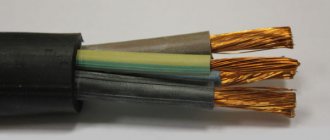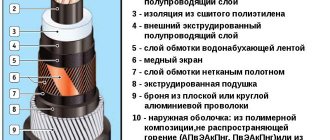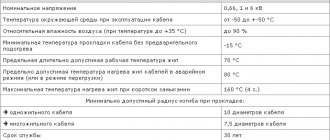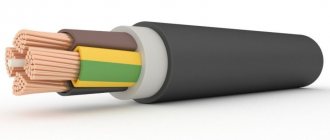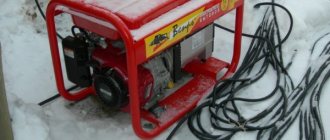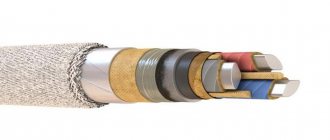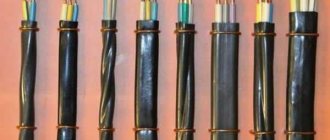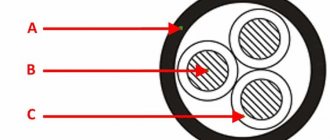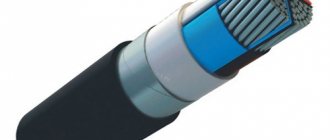The VVG 5x6 brand cable is a copper-core power cable, which is often used in repair and construction work. In accordance with the requirements of current codes and regulations, the use of VVG cable is impossible inside buildings. This restriction was introduced to improve the fire safety of residential and non-residential premises.
Characteristics of cable VVG 5x6 according to GOST 31996-2012
The VVG 5x6 cable has a polyvinyl chloride insulating layer and an outer sheath and is used for circuits that meet the following conditions:
- mains voltage no more than 1000 V;
- network frequency no more than 50 Hz.
Explanation of the VVG 5x6 cable designation
- B - “vinyl”, the insulation is made of polyvinyl chloride plastic;
- B - “vinyl”, the shell is made of polyvinyl chloride plastic;
- G - “naked”, there is no armor in the cable;
- P (if available) - flat cable design;
- 5 - number of cores;
- 6 - cross-sectional area of one copper core, mm2.
Technical characteristics and service life
- AVVG cables are operated at ambient temperatures from minus 50 °C to plus 50 °C.
- The cables are operational at relative humidity up to 98% at temperatures up to 35 °C, according to GOST 15510-69.
- The electrical resistance of current-carrying conductors to direct current must comply with GOST 22483.
- Electrical insulation resistance of cores, 1 km length at a temperature of 20 °C, not less than:
- 10 MOhm, for conductors with a nominal cross-section of 2.5 - 4 mm2;
- 9 MOhm, for conductors with a nominal cross-section of 6 mm2;
- 7 MOhm, for conductors with a nominal cross-section of 10 – 240 mm2.
- AC test voltage with a frequency of 50 Hz for AVVG cables
Rated voltage, kV Test voltage, kV 0,66 3 1,0 3,5 - The warranty period for cables is 5 years from the date of commissioning.
- The service life of the AVVG cable is at least 30 years.
AVVG
Power cables / Catalog / Power cables / Power cables with plastic insulation / AVVG
Power cables with plastic insulation are intended for the transmission and distribution of electrical energy in stationary electrical installations at rated alternating voltages of 0.66, 1 kV and 3 kV.
1. Preferred area of application
Climatic modifications UHL and T, placement categories 1 and 5 according to GOST 15150-69. HL cables are intended for the transmission and distribution of electrical energy in stationary installations with a rated alternating voltage of 0.66; 1 rated frequency up to 100 Hz. Types of climatic modifications of cables HL, placement category 1, 2 and 5 according to GOST 15150.
2. Design
The conductor is aluminum or copper, single-wire or multi-wire.
The insulation is made of polyvinyl chloride plastic for cables of the brands AVVG, VVG, AVVGE, VVGE, AVVGng(A), VVGng(A), AVVGEng(A), VVGEng(A), AVBShv, VBShv, AVBShvng(A), VBShvng(A); for cables of brands APvVG, PvVG, APvVGE, PvVGE, APvVGng(A), PvVGng(A), APvVGEng(A), PvVGEng(A), APvBShv, PvBShv, APvBShvng(V), PvBShvng(V), APvBShp, PvBShp-iz silanol crosslinkable polyethylene.
The inner sheath of unarmored cables is made of polyvinyl chloride plastic compound or chalk-filled unvulcanized rubber mixture. In armored cables of brands VBShv, AVBShv, PvBShv and APvBShv - from polyvinyl chloride plastic compound, in cables of brands APvBShp and PvBShp - from polyvinyl chloride plastic compound or polyethylene, in cables of brands AVBShvng(A), VBShvng(A), APvBShvng(V), PvBShvng(V) ) – made of polyvinyl chloride plastic compound of reduced flammability.
The screen in shielded cables of the brands AVVGE, VVGE, AVVGEng(A), VVGEng(A), APvVGE, PvVGE, APvVGEng(A), PvVGEng(A) is made of copper tape or copper wires fastened with copper tape.
The sheath for cables of brands AVVG, VVG, AVVGE, VVGE, APvVG, PvVG, APvVGE, PvVGE is made of polyvinyl chloride plastic compound, in cables of brands AVVGng(A), VVGng(A), AVVGEng(A), VVGEng(A), APvVGng(A) ), PvVGng(A), APvVGEng(A), PvVGEng(A) - made of polyvinyl chloride plastic compound of reduced flammability.
The armor in armored cables of the brands AVBShv, VBShv, AVBShvng(A), VBShvng(A), APvBShv, PvBShv, APvBShvng(V), PvBShvng(V), APvBShp and PvBShp is made of flat galvanized steel strips.
The protective hose in armored cables of the brands AVBShv, VBShv, APvBShv, PvBShv is made of polyvinyl chloride plastic compound, in cables of the brands AVBShvng(A), VBShvng(A), APvBShvng(V), PvBShvng(V) - from polyvinyl chloride plastic compound of reduced flammability, in cables APvBShp and PvBShp brands – made of polyethylene.
The nominal cross-section of the cores is from 1.5 to 1000 mm2, depending on the cable brand, number of cores and rated voltage.
Cables are made with one, two, three, four or five cores. Multicore cables are manufactured with cores of equal cross-section. Four-core cables may have one conductor of a smaller cross-section. HL cables are manufactured with one-, two-, three-, four- and five-core cables for a rated voltage of 0.66 and 1 kV with a frequency of 50 Hz. The current-carrying conductors of five-core power cables of category HL must be single- or multi-wire.
3. Installation and operating instructions
The operating temperature limits of the environment are from minus 50 °C to plus 50 °C (except for cables with a protective polyethylene hose) and relative air humidity up to 98% at temperatures up to 35 °C.
Cables with a protective polyethylene hose are designed for operation at ambient temperatures from minus 60°C to plus 50°C.
Cables of the HL category are intended for operation at ambient temperatures from minus 60°С to plus 50°С, cables of all brands with the index “ng” - from minus 50°С to plus 50°С, cables of all brands with the index “ng-ХЛ” -60" and "mb" - from minus 60°C to plus 50°C.
4. Cable characteristics
4.1 Permissible current loads of cables with insulation made of polyvinyl chloride plastic compounds
| Nominal core cross-section, mm2 | Permissible current load of cables, A | |||||||||||
| Single-core | Stranded** | |||||||||||
| on direct current | on alternating current* | on alternating current* | ||||||||||
| with copper core | with aluminum core | with copper core | with aluminum core | with copper core | with aluminum core | |||||||
| on air | in the ground | on air | in the ground | on air | in the ground | on air | in the ground | on air | in the ground | on air | in the ground | |
| 1,5 | 29 | 41 | — | — | 22 | 30 | 21 | 27 | ||||
| 2,5 | 37 | 55 | 30 | 32 | 30 | 39 | 22 | 30 | 27 | 36 | 21 | 28 |
| 4 | 50 | 71 | 40 | 41 | 39 | 50 | 30 | 39 | 36 | 47 | 29 | 37 |
| 6 | 63 | 90 | 51 | 52 | 50 | 62 | 37 | 48 | 46 | 59 | 37 | 44 |
| 10 | 86 | 124 | 69 | 68 | 68 | 83 | 50 | 63 | 63 | 79 | 50 | 59 |
| 16 | 113 | 159 | 93 | 83 | 89 | 107 | 68 | 82 | 84 | 102 | 67 | 77 |
| 25 | 153 | 207 | 117 | 159 | 121 | 137 | 92 | 106 | 112 | 133 | 87 | 102 |
| 35 | 187 | 249 | 143 | 192 | 147 | 163 | 113 | 127 | 137 | 158 | 106 | 123 |
| 50 | 227 | 295 | 176 | 229 | 179 | 194 | 139 | 150 | 167 | 187 | 126 | 143 |
| 70 | 286 | 364 | 223 | 282 | 226 | 237 | 176 | 184 | 211 | 231 | 161 | 178 |
| 95 | 354 | 436 | 275 | 339 | 280 | 285 | 217 | 221 | 261 | 279 | 197 | 214 |
| 120 | 413 | 499 | 320 | 388 | 326 | 324 | 253 | 252 | 302 | 317 | 229 | 244 |
| 150 | 473 | 561 | 366 | 434 | 373 | 364 | 290 | 283 | 346 | 358 | 261 | 274 |
| 185 | 547 | 637 | 425 | 494 | 431 | 142 | 336 | 321 | 397 | 405 | 302 | 312 |
| 240 | 655 | 743 | 508 | 576 | 512 | 477 | 401 | 374 | 472 | 471 | 359 | 363 |
| 300 | 760 | 845 | 589 | 654 | 591 | 539 | 464 | 423 | 542 | 533 | 424 | 417 |
| 400 | 894 | 971 | 693 | 753 | 685 | 612 | 544 | 485 | 633 | 501 | 482 | |
| 500 | 1054 | 1121 | 819 | 870 | 792 | 690 | 636 | 556 | — | |||
| 625/630 | 1252 | 1299 | 971 | 1007 | 910 | 774 | 744 | 633 | — | |||
| 800 | 1481 | 1502 | 1146 | 1162 | 1030 | 856 | 858 | 713 | — | |||
| 1000 | 1718 | 1709 | 1334 | 1327 | 1143 | 933 | 972 | 793 | — | |||
4.2 Permissible heating temperatures of conductors
| Cable insulation material | Long-term permissible core heating temperature, °C | In overload mode | Limit at short circuit | According to the condition of non-ignition in case of short circuit |
| Polyvinyl chloride plastic compound | 70 | 90 | 160/140* | 350 |
| Cross-linked polyethylene | 90 | 130 | 250 | 400 |
*For cables with conductive cores with a cross-section of more than 300 mm
Operating instructions:
- Table of maximum voltages of electrical networks for which the AVVG cable is used:
Rated cable voltage, kV Maximum voltage of the three-phase network for which the cable is intended, kV 0,66 0,72 1,0 1,2 - AVVG cables must be used in accordance with the “Unified Technical Guidelines for the Selection and Use of Electrical Cables”.
- Cable laying must be carried out in accordance with the current “Electrical Installation Rules” (PUE) and technical documentation approved in the prescribed manner.
- It is allowed to lay cables without preheating at a temperature not lower than minus 15 °C.
- The minimum bending radius during installation must be at least 7.5 Dn for multi-core cables and at least 10 Dn for single-core cables (Dn is the outer diameter of the cable, mm.)
- The long-term permissible heating temperature of the cores during operation should not exceed 70 °C.
- The maximum permissible core temperature during a short circuit should not exceed 160 °C. The duration of the short circuit should not exceed 4 seconds.
- The permissible heating of cable cores in emergency mode should not exceed 80 °C. The duration of cable operation in emergency mode should not exceed 8 hours per day and 1000 hours over the entire service life of the cable.
- AVVG cables can be used in DC networks at voltage values 2.4 times higher than the voltage between the core and the screen or metal sheath.
- The electrical insulation resistance per 1 km of length, measured at the long-term permissible heating temperature of the cable cores during operation, must be at least 0.005 MOhm.
- Permissible current loads and permissible short-circuit currents must correspond to the table values:
Nominal core cross-section, mm2 Permissible current loads on cable AVVG, A Permissible one-second short circuit current of AVVG cables, kA Single-core Double-core Three-core On air In the ground On air In the ground On air In the ground 2,5 30 32 25 33 21 23 0,18 4 40 41 34 43 29 37 0,29 6 51 52 43 54 37 44 0,42 10 69 68 58 72 50 59 0,70 16 93 83 77 94 67 77 1,13 25 122 113 103 120 88 100 1,81 35 151 136 127 145 109 121 2,50 50 189 166 159 176 136 147 3,38 70 233 200 — — 167 178 4,95 95 284 237 — — 204 212 6,86 120 330 269 — — 236 241 8,66 150 380 305 — — 273 274 10,64 185 436 343 — — 313 308 13,37 240 515 396 — — 369 355 17,54
Design features of VVG 5x6
The table below shows the design features of the cable.
| Characteristic name | Unit change | Meaning |
| Number of cores | PC. | 5 |
| Maximum core diameter | mm | 2.9 |
| Cable outer diameter, 0.66 kV | mm | 15 |
| Cable outer diameter, 1 kV | mm | 16.5 |
| Weight Limit | kg/m | 0.516 |
| Core material | — | Copper |
| Insulation material | — | PVC |
| Shell material | — | PVC |
| Core construction type | — | OK |
Core design options:
- ok - single-wire core;
- mk - multi-wire core.
Decoding of VVG and description
The first letter “B” stands for core insulation made of polyvinyl chloride. The second "B" also indicates the PVC insulation used as the overall cable sheath. The letter "G" corresponds to the designation "flexible" or "naked" because there is no armor covering over the shell. Thus, the name VVG stands for “vinyl-vinyl-naked.” The absence of any letters before the name indicates conductors made of copper.
The VVG cable uses copper conductors. The rated voltage for ordinary cables is 220/380 volts, and for power cables - 600/1000 volts. In this regard, they are widely used in various fields, including industry, everyday life, offices and other premises. Using VVG cables, industrial devices and equipment, street lighting and home electrical networks are connected. The recommended temperature when laying the wire should be at least 15C. For installation in the ground, cable ducts or PVC pipes are required to protect against mechanical damage.
The use of VVG cable is considered the safest and most profitable option. Its protection is much better than that of conventional wires. This wire is used in the construction of new houses. The cross-section for connecting sockets is 2.5 mm², and for lighting – 1.5 mm². Electric stoves are connected with a more powerful cable, at the rate of 1 mm² per 2 kW load.
The VVG cable can be two-, three-, four- or five-core. Some designs have an additional grounding and neutral conductor. Different colors make connection much easier. The neutral conductors are denoted in blue or cyan, and the grounding is yellow-green.
Application area
Cables of the VVGng brand are used for transmission and distribution of electric power with stationary installation at a rated alternating voltage of 0.66 kV and 1 kV frequency of 50 Hz.
VVGng cables are intended for use indoors, outdoors, electrical installations (ducts, pipes, trays, tunnels, etc.) in the absence of tensile loads on the cable.
VVGng cables are used in cases where increased fire safety is required to prevent the spread of combustion when laying cables in bundles. Corresponds to category A GOST 12176.
Design AVVG 2x4
- 1. Two aluminum conductors with a cross-sectional area of 4 mm2
Minimum number of wires (round) core 1 pieceElectrical resistance of 1 km of core at a temperature of 20 ° C 7.41 Ohm
Weight of aluminum in 1 meter of core 0.011 kg
- 2. Polyvinyl chloride (PVC) insulation
Nominal insulation thickness 1mmMinimum insulation thickness0.8mm
Insulation resistance 10.1 MOhm
- 3. Filling with PVC plastic or unvulcanized rubber mixture - to give the cable an almost round shape, the internal and external spaces between the insulated cores must be filled.
- 4. Inner shell made of polyvinyl chloride (PVC) plastic compound
Nominal inner shell thickness 1mmMinimum thickness of the inner shell 0.5mm
- 5. PVC sheath
Outer shell thickness 1.5mmMinimum outer shell thickness 1.175mm
Selecting VVG cable for apartment wiring
To supply electricity to the panel at the entrance to the apartment, as a rule, a VVG 3X6 power cable is used (can also be 3X10 and 3X16). Unlike PVS and ShVVP wires, often used for installation of electrical wiring, copper cable VVG 2X4 meets higher requirements, since it is also intended for use in industry. In other words, VVG 2X4, with an equal cross-section, has a higher maximum permissible current, higher insulation quality, and supports combustion much worse. In addition, each such product undergoes production tests, which cannot be said about most of their household analogues. As for the choice of the type and cross-section of the cable for powering electrical appliances located in the apartment itself, then everything depends, first of all, on their technical characteristics. One of the most common is the VVG 2X4 brand.
